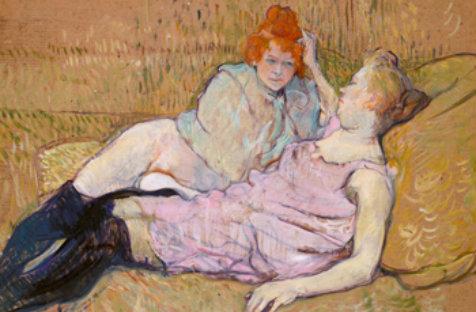The late great Australian painter Clifton Pugh once commented that he preferred painting portraits of men.
An accomplished portrait artist, Pugh complained women were too concerned with their appearance and masked their personalities behind their efforts at beauty.
Toulouse Lautrec does not just overcome Pugh’s challenge. In painting the prostitutes and dancers of turn of the century Paris, he actually paints the very dichotomy Pugh identifies.
He shows us the resignation, boredom, cynicism and occasionally true intimacy beneath the frills and feathers of the can-can culture.
Lautrec is a unique artist whose multiple abilities are ill-served by our over-familiarity with poor reproductions of his famous Moulin Rouge and El Dorado posters.
The poster originals are in the exhibition. Huge in both scale and impact, their legacy to 100 years of design and advertising alone would make them worthy of serious consideration. But they are not just historical artefacts. Lautrec captures the mood and personality of the cabaret with his striking sketches and silhouettes, based on a mastery of line.
Seen in the broader context of an exhibition that includes portraits, lithographs, book illustrations and a scattering of animals, the posters bear examination as art but they are not the highlight of the exhibition.
Lautrec draws beautifully, and the less dramatic (and less well-known) lithographs are magic. The Elles series of 10 lithographs and a frontispiece captures the daily lives of women in a brothel – bathing, eating, dressing and resting. There is a tremendous intimacy and humanity in these pictures.
The disabled and outcast artist may have ended up in the underbelly of Parisian society because he was not accepted in more desirable circles but he gained access and a capacity to paint truth that he could never have found doing society portraits. The perfect line of Woman Washing Herself, a sepia coloured planograph print, contains a beauty the most sumptuous oils cannot capture.
Similarly, there is a raw social truth in Alone, an oil on cardboard image of a woman exhausted on a bed, implicitly a prostitute worn out by pleasing the customer who has left. In neither of these pictures do we see the woman’s face but in both cases the posture and line gives us a strong sense of her emotions.
The Sofa shows two prostitutes lying side by side, one exhausted, the other fed-up, their careless clothing a remnant of the role they are forced to perform. Again the artist uses the raw base of cardboard; a perfect medium for the gritty reality he portrays.
Lautrec draws rather than paints and often chooses only to fill in the colour of part of the work, using the bare canvas and sometimes cardboard as a comment within the work. In Seated Woman, the head, breast and neck rise out of a sketched body but there is a brilliant halo of paint dabs around the head. In this picture, the face is all. The tired prostitute-model looks wearily but directly at the viewer so that it is her knowing eyes and not her exposed breast that strike us.
In The Englishman at the Moulin Rouge, the carousing gentleman is a mere sketch in brown while the heavily dressed but scornful women are in full colour. Lautrec often veers to caricature, as he does in the expressions of the women in this encounter and in the genuinely funny book cover for Victor Joze’s novel, Reine de Joie, where the apparent affection of the courtesan is balanced by her hard eyes and careful lips while the fat old fool in her arms is sucked in by her power.
At the end of the exhibition there are a few more fully realised oils on canvas, including La Goulue entering the Moulin Rouge, the poster choice for the exhibition. This portrait of the notoriously risqué dancer with a twisted knowing smile is a masterful example of Lautrec’s ability to capture personality.
Another of these great culmination works is Tete-a-Tete Supper, where the overdressed beauty of the courtesan appears to spoil in front of us, like the over-ripe fruit in the bowl beside her. Her partner is half off canvas, a comment on the real place of these men in the lives of the women of Montmartre.
One of the most beautiful works is easy to miss. It is an illustration for the German journal Pan, a bust of actress Marcelle Lender in crayon, brush and spatter lithograph in bold colour displayed in a glass case. In his use of colour and the ornate background, Lautrec prefigures Matisse in this lovely image; perhaps not the portrait with the most personality but one that gives true aesthetic satisfaction. Make sure you see it.
I expected to enjoy this exhibition but it was better than I expected. Curator Dr Jane Kinsman has done a superb job in choice and display and lifted this excellent artist to a higher level of audience appreciation.
Rating: 4 stars out of 5
Toulouse-Lautrec: Paris and the Moulin Rouge
National Gallery of Australia
14 December – 2 April





